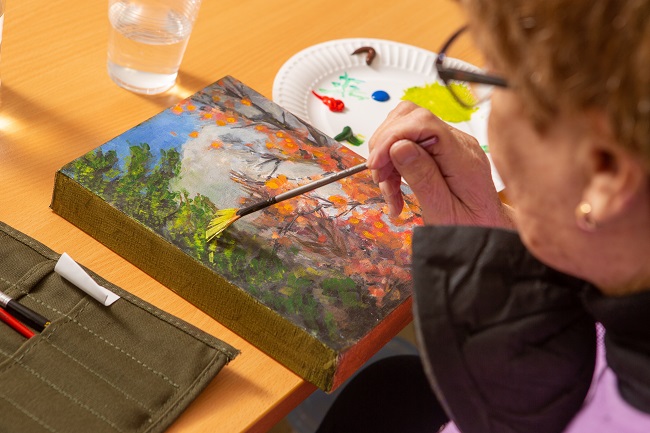Art as therapy in aged care: what you need to know
Here we explore the role of art as therapy in residential aged care, particularly for those living with dementia.

All human beings are creative by nature, but as we grow older many of us lose touch with our creative abilities. Raising families, pursuing careers and life itself can get in the way of exploring our creativity. But now there is growing recognition that creativity plays a vital role in maintaining our health and wellbeing as we age.
“Every child is an artist. The problem is how to remain an artist once we grow up.” - Pablo Picasso
Here we explore the role of artistic pursuits in residential aged care, particularly for those living with dementia, and look at some of the ways the aged care sector can embrace creativity to improve the lives of their residents.
What is Art Therapy?
Art therapy is a form of psychotherapy that uses creative processes to support emotional and psychological wellbeing. Unlike a regular art class or hobby activity, art therapy is facilitated by a trained professional who combines the creative arts with principles of clinical psychology.
According to the Australian, New Zealand and Asian Creative Arts Therapies Association, arts therapists use a range of methods—like painting, drawing, movement, and storytelling—to help individuals express themselves, explore emotions, improve self-awareness, and manage anxiety.
While formal art therapy isn’t offered in residential aged care centres, including those run by IRT, creative activities can still be deeply therapeutic. Engaging in arts and crafts, music, dance, writing, gardening or cooking can bring joy, connection, and a sense of purpose, supporting both physical and mental wellbeing.
Creative arts and dementia
According to the UK’s Mental Health Foundation, a review of 31 global studies found participatory art can help improve cognitive functioning, communication, self-esteem, musical skills, pleasure, enjoyment of life, memory and creative thinking in older people with dementia. Dr Louisa Smith, a research fellow at the University of Wollongong’s Australian Health Services Research Institute, has a particular interest in the value of creative pursuits for people living with dementia in residential aged care.
Eight ideas for art therapy
1. Think about arts more broadly
Creativity can involve much more than painting and drawing and other conventional forms of art. Dr Smith views artistic activities as multi-modal forms of engagement that foster connection.
Across the globe there’s a growing creative ageing movement that embraces a whole range of artistic activities, including making something.
“It has involved reinvigorating men’s sheds, sewing circles, knitting circles – activities that people have done their whole lives and are still included in art-making,” Dr Smith explains.
“So many people have a rich creative history. We really need to support older people to enliven that history in the present.”
2. Tailor programs to individuals
Dr Smith says arts activities in residential aged care are usually designed by the aged care centre and offered to the residents as group-based activities.
“It might be water colours, collage or scrapbooking. Some people in that centre might be interested in those activities, but they don’t suit everyone.
“The reality is these activities work best when they’re based on the interests and passions of residents themselves and when they have a say in how they evolve.”
This approach aligns with the new Australian Aged Care Quality Standards, which highlight the importance of residents being able to make their own choices and for them be engaged in meaningful activities that are satisfying to them.
3. Offer a wide variety of activities
She acknowledges it can be challenging to design appropriate activities for people with dementia.
“You need to think about the activities that make them feel really comfortable within themselves and connected, and work out what supports they need to do those things.
“For someone it might be mowing the lawn; for someone else it might be knitting. For someone with dementia, if it is not in front of them and placed in their hands they’re probably not going to do it, but it doesn’t mean they don’t want to.”
She recommends creating a whole range of offerings, which she calls provocations.
4. Create the right environment
“In a Montessori-based approach, a lot of things are placed around the person’s space which allows them to interact when they think it is appropriate, rather than at a set time.”
In this way the environment itself becomes a creative space because it holds a series of options. This challenges existing thinking because the space around people living with dementia is often cleared to protect them.
“We need to have some reverence for the capacity of the people with dementia to engage with rich environments.
“An environmentally impoverished space that doesn’t hold a lot of stimulus is more likely to lead to negative behaviours.”
Discover the benefits of music therapy in aged care
Subscribe to our newsletter

Discover the benefits of pet therapy in aged care
5. Get to know the resident
There’s no doubt devising and supporting individual activities takes a lot of time, particularly for those with advanced dementia. That’s where a person-centred approach becomes critical.
It is really important to collect as much information as possible about a resident when they move in – their history and interests, likes and dislikes. That process usually includes talking to family and friends.
“Watch what they choose to engage with and curate something that is bespoke. In this way the resident is actually designing their activities as they are going, as they are feeling, as they’re touching. So you are co-designing with them.”
6. Support the resident
Step 1: Help them start the activity
It is not enough to identify and organise bespoke activities, there also needs to be a lot of support – or scaffolding – to help the resident enter into the activity.
“They need a facilitator to support them to enter the moment of doing that art,” Dr Smith explains.
Step 2: Support them duirng the activity
This might involve creating a space without distractions, practical help – holding a brush, turning a page – as well as encouragement.
“This is a really productive way of supporting the wellbeing of someone with dementia because it enables connection and relationships with other people. And it supports them to be in the moment, which is when they are at their best.”
Step 3: help them to end the activity
The resident will also need to be guided when the activity is complete.
“They need support to exit the activity – it might be as simple as saying: ‘Oh, look what we did. We’ve done this great artwork.’ And then later it’s important to relive the moment with them.
“So the facilitator really needs to guide them through the process.”
7. Offer individual activities
Many aged care centres have activities coordinators who are responsible for planning the residents’ activities. Although this often involves group activities, Dr Smith says there needs to be a focus on individual activities as well.
“Some people find group activities overwhelming and for some people with dementia sitting with a group of 20 people can be cognitive hell.
Although it isn’t always possible for the carers themselves to find time to engage residents in creative pursuits, Dr Smith says there are many advantages if they can do so.
“It helps remind staff of who the resident is and they become more connected.
“Just tiny moments of creative connection and exchange make everyone feel better. Then the work is more satisfying and fulfilling for the carers.”
8. Involve the wider community
Beyond volunteers at the aged care centre, Dr Smith also believes there’s great scope for bringing the community to aged care centres as a way to increase access to a range of different activities.
“Rather than see the aged care centre as a place apart from the community, we can view it as a community hub. We need to find ways to link the residents in to community activities they used to enjoy.”
It could involve arranging for the local men’s shed, community choir, writers’ group or artists’ collective to visit the aged care centre to engage with the residents.
Dr Louisa Smith Smith is a Research Fellow at AHSRI and the School of Social Sciences at UOW. She does research with people with disabilities, including dementia, which aims to support participation, creativity and wellbeing. Twitter: @LouisaESmith1
Does your loved one need support?
IRT has been supporting older Australians and their families with compassionate care for more than 50 years with aged care centres in NSW, Qld and the ACT. If your loved one needs warm and personalised care you can trust, we'd be more than happy to help.
You may also like
What is the difference between CHSP and Home Care Packages?
If you’re interested in getting some home care, you’ve likely heard of the terms ‘Home Care Package’ and ‘Commonwealth Home Support Program.’
Pet Therapy in Aged Care: How Animal Companionship Improves Wellbeing
You’ve most likely heard the saying “dogs are a man’s best friend,” but dogs and other pets alike can often do much more for a…


